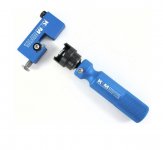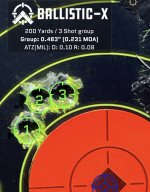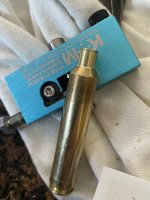- Thread starter diderr
- Start date
You are using an out of date browser. It may not display this or other websites correctly.
You should upgrade or use an alternative browser.
You should upgrade or use an alternative browser.
Use a carbide turning mandrel as it helps a lot in keeping any heating down if you wish to not use any lube or with lube, it tends to run even smoother when using just a little lube. They're not cheap, but they'll last your life time.Been reloading a lot of years and finally dove into buying a neck turner. Any advise on setup and process?
Make sure you use the correct angle cutter for your cartridge(s) and cut ever so slightly into the neck-shoulder junction. Be sure that you're trimming results in a consistent distance from the neck's mouth to the neck-shoulder junction so that cut into that area is also consistent and not too deep on some of them.
If you're turning for different calibers, use a dedicated cutter unit for each caliber. This way you can keep turning very consistent.
Thanks a bunch! And I did order the one with the carbide cutter
So what’s the order of brass prep?Use a carbide turning mandrel as it helps a lot in keeping any heating down if you wish to not use any lube or with lube, it tends to run even smoother when using just a little lube. They're not cheap, but they'll last your life time.
Make sure you use the correct angle cutter for your cartridge(s) and cut ever so slightly into the neck-shoulder junction. Be sure that you're trimming results in a consistent distance from the neck's mouth to the neck-shoulder junction so that cut into that area is also consistent and not too deep on some of them.
If you're turning for different calibers, use a dedicated cutter unit for each caliber. This way you can keep turning very consistent.
Size
Trim
Neck turn?
You should only have to neck turn once. I do it on once-fired brass prior to sizing, but that's just me.
An important tip: you don't have to take off lots of brass, just normalize the thickness of the necks. If you slide a case onto the turner and it only takes off a little patch on one side THAT'S OK! That neck is now uniform to the cutter distance. Don't adjust the cutter in hopes of taking off brass around the entire neck. Just set a cutting depth and let the cutter do the work.
Also, don't forget to use a bit of lube on the mandrel and replenish it from time to time while turning.
An important tip: you don't have to take off lots of brass, just normalize the thickness of the necks. If you slide a case onto the turner and it only takes off a little patch on one side THAT'S OK! That neck is now uniform to the cutter distance. Don't adjust the cutter in hopes of taking off brass around the entire neck. Just set a cutting depth and let the cutter do the work.
Also, don't forget to use a bit of lube on the mandrel and replenish it from time to time while turning.
SizeSo what’s the order of brass prep?
Size
Trim
Neck turn?
Trim
Expander mandrel......don't forget this
Turn
Because virgin brass can have substantial differences between the neck-shoulder junction, I always fire form them first. Depending on your brass and whether you anneal the brass or not, that may be only one firing. Non-annealed brass often takes two firings . . . sometimes three. I only reload for my .308 and 6.5 PRC and since I anneal them, I find I only really need to fire form my cases once before I turn them.So what’s the order of brass prep?
Size
Trim
Neck turn?
So, after fire forming this is my order of brass prep:
*Deprime
*Anneal
*Clean (to remove the oxidation off the inside and outside of the neck from the annealing process)
*Size (no expander ball in die)
*Clean (to remove lube)
*Expand neck (using proper expander mandrel for proper fit over the turning mandrel)
*Trim (using a 3-way trimmer that indexes off the shoulder that helps with uniform trimming)
*Turn necks to desired neck thickness (slowly adjusted so there's no skipped areas on my necks, then always keep it set to that amount of cut for that amount of shoulder bump measurement)
I've even turned necks on my nickel plated brass
Last edited:
Don’t bother lol.Been reloading a lot of years and finally dove into buying a neck turner. Any advise on setup and process?
Thanks for the help guys!
Been reloading a lot of years and finally dove into buying a neck turner. Any advise on setup and process?
My advice is get a turning station that allows you to run a drill or motor, like the 21st Century. Neck size the brass a half thousandth under (interference) the turning mandrel. You'll need a light lube for the necks but they'll be concentric.
Neck turning isn't hard once you have the process figured out. I wish I hadn't waited as long as I did.
Remove the blue handle from the case holder head and put it back in the bag.
Install the case holder in a battery operated drill set on low speed.
Practice on scrap brass to get your technique correct.
Insert the mandrel into the neck and start the drill before making contact with the brass.
Do not push the cutter in towards the shoulder. Once it starts cutting, it'll guide itself all the way to the shoulder.
Once it hits the shoulder, slowly begin to pull the cutter back towards the base mouth to allow it another skim. If you don't it'll leave a cut line on the neck.
Turn the necks in two separate steps unless you're just doing a skim cut.
These are 12x fired Lapua 6-BR that just got another skim cut to .261 loaded diameter. (Not annealed)
The K&M cutter is from circa 2001 and never changed.

Install the case holder in a battery operated drill set on low speed.
Practice on scrap brass to get your technique correct.
Insert the mandrel into the neck and start the drill before making contact with the brass.
Do not push the cutter in towards the shoulder. Once it starts cutting, it'll guide itself all the way to the shoulder.
Once it hits the shoulder, slowly begin to pull the cutter back towards the base mouth to allow it another skim. If you don't it'll leave a cut line on the neck.
Turn the necks in two separate steps unless you're just doing a skim cut.
These are 12x fired Lapua 6-BR that just got another skim cut to .261 loaded diameter. (Not annealed)
The K&M cutter is from circa 2001 and never changed.
I planned on just using my drill with it. I don’t hand turn anything anymore. couple thousand 223 brass ruined hand turning for me 
You can purchase that item, or just make sure the opening is facing up on the shell holder. That will ensure the case rim is properly seated before tightening.
It takes less than 1/4 turn to go from loose enough to remove, to tight.
It takes less than 1/4 turn to go from loose enough to remove, to tight.
Feniks Technologies
Premium Ammunition and Loading Supplies
Supporter
Commercial Supporter
Full Member
Minuteman
Advice for neck turning:
- Know why you’re turning necks. If the reason is a “tight neck chamber,” then you have the wrong reamer. If you haven’t chambered barrel, get the right reamer for your brass.
You use a tight neck chamber *because* you intend to neck turn, not after.
You should only be neck turning for a performance increase. More consistent brass prep and neck consistency. And you need to be 1) capable of exploiting this and 2) shooting a discipline which the exploitation is possible. I.E. shooting off a barricade has too much wobble to exploit minor precision upgrades.
- Decide if you’re going to skim turn outside, full turn outside, or full turn inside and outside. Each has different reasons and may require different tools.
- fireforming before neck turning is currently only done when you will be radically changing the brass during fireforming.
Most any top F or BR shooter now is turning virgin brass and just cutting into the shoulder.
If you’re necking down a lot that induces runout, or you’re changing the dimensions drastically, then you need to fireform first (provided your chamber has enough neck clearance to chamber a round).
Otherwise, just turn virgin and into the shoulder.
- Know why you’re turning necks. If the reason is a “tight neck chamber,” then you have the wrong reamer. If you haven’t chambered barrel, get the right reamer for your brass.
You use a tight neck chamber *because* you intend to neck turn, not after.
You should only be neck turning for a performance increase. More consistent brass prep and neck consistency. And you need to be 1) capable of exploiting this and 2) shooting a discipline which the exploitation is possible. I.E. shooting off a barricade has too much wobble to exploit minor precision upgrades.
- Decide if you’re going to skim turn outside, full turn outside, or full turn inside and outside. Each has different reasons and may require different tools.
- fireforming before neck turning is currently only done when you will be radically changing the brass during fireforming.
Most any top F or BR shooter now is turning virgin brass and just cutting into the shoulder.
If you’re necking down a lot that induces runout, or you’re changing the dimensions drastically, then you need to fireform first (provided your chamber has enough neck clearance to chamber a round).
Otherwise, just turn virgin and into the shoulder.
Feniks Technologies
Premium Ammunition and Loading Supplies
Supporter
Commercial Supporter
Full Member
Minuteman
And the best neck turning advice for 99% of shooters:
Don’t. It won’t improve your ammo.
Use a mandrel instead. Will give you almost all the advantages of neck turning.
Don’t. It won’t improve your ammo.
Use a mandrel instead. Will give you almost all the advantages of neck turning.
Basically speaking I’m trying to make “meh” brass good. It’s for a Weatherby cartridge so I’m stuck with Weatherby brass. If I could get norma or lapua I would just load and go. I want to get even neck thickness of 0.013. A few pieces I’ve measured had high spots up to 0.016 and 0.013 on the lowsAdvice for neck turning:
- Know why you’re turning necks. If the reason is a “tight neck chamber,” then you have the wrong reamer. If you haven’t chambered barrel, get the right reamer for your brass.
You use a tight neck chamber *because* you intend to neck turn, not after.
You should only be neck turning for a performance increase. More consistent brass prep and neck consistency. And you need to be 1) capable of exploiting this and 2) shooting a discipline which the exploitation is possible. I.E. shooting off a barricade has too much wobble to exploit minor precision upgrades.
- Decide if you’re going to skim turn outside, full turn outside, or full turn inside and outside. Each has different reasons and may require different tools.
- fireforming before neck turning is currently only done when you will be radically changing the brass during fireforming.
Most any top F or BR shooter now is turning virgin brass and just cutting into the shoulder.
If you’re necking down a lot that induces runout, or you’re changing the dimensions drastically, then you need to fireform first (provided your chamber has enough neck clearance to chamber a round).
Otherwise, just turn virgin and into the shoulder.
Feniks Technologies
Premium Ammunition and Loading Supplies
Supporter
Commercial Supporter
Full Member
Minuteman
Basically speaking I’m trying to make “meh” brass good. It’s for a Weatherby cartridge so I’m stuck with Weatherby brass. If I could get norma or lapua I would just load and go. I want to get even neck thickness of 0.013. A few pieces I’ve measured had high spots up to 0.016 and 0.013 on the lows
That’s a valid reason.
For that much, you could benefit from having someone do the ID and OD on an idod machine.
I was just watching one of Erik’s videos today on the idod. Seems like a nice piece of equipment. Once this barrel burns out it will be 6.5-284. And the vast tolerance inconsistencies on $2.75 a piece brass will go away when I can get $1.50 a piece LapuaThat’s a valid reason.
For that much, you could benefit from having someone do the ID and OD on an idod machine.
Attachments
You need a separate mandrel and die to neck the cases up for turning.
Make sure you buy the same brand because they are designed to neck up to match your turning mandrel.
Make sure you buy the same brand because they are designed to neck up to match your turning mandrel.
When I turn neck it is either because I have a tight neck chamber or because I want to clean up the brass.
If I am just cleaning up the high spots I look for about a 50-75% clean up. That way I dont screw them up and make things hard on myself.
I got the 21st Century powered lathe and it makes a pain in the ass job much easier.
If I am just cleaning up the high spots I look for about a 50-75% clean up. That way I dont screw them up and make things hard on myself.
I got the 21st Century powered lathe and it makes a pain in the ass job much easier.
Feniks Technologies
Premium Ammunition and Loading Supplies
Supporter
Commercial Supporter
Full Member
Minuteman
Just for anyone who might be reading that doesn’t turn necks or is having a barrel chambered soon.
A tight neck chamber in and of itself doesn’t do much at all. It shouldn’t be your reason for turning necks unless you somehow found yourself with a barrel you didn’t realize had a tight neck.
Tight neck chambers are utilized when you intend to neck turn brass and don’t want a large neck clearance (most modern data shows that neck clearance really doesn’t matter much, but that’s another conversation).
Point being, before you have a chamber cut, make sure you know what reamer is being used to cut the chamber. Verify the dimensions fit what you’re intending to do.
For 99% of shooters, beck turning is all but a waste of time. So do what you can to avoid it if it’s not your plan to neck turn already.
A tight neck chamber in and of itself doesn’t do much at all. It shouldn’t be your reason for turning necks unless you somehow found yourself with a barrel you didn’t realize had a tight neck.
Tight neck chambers are utilized when you intend to neck turn brass and don’t want a large neck clearance (most modern data shows that neck clearance really doesn’t matter much, but that’s another conversation).
Point being, before you have a chamber cut, make sure you know what reamer is being used to cut the chamber. Verify the dimensions fit what you’re intending to do.
For 99% of shooters, beck turning is all but a waste of time. So do what you can to avoid it if it’s not your plan to neck turn already.
i ordered a 38 degree cutter so I can get down to the shoulder more versus fighting a 50 degree
Definitely not ignoring! A lot of good tips in here and taking noteOP asks for tips then ignores tips.
Definitely not ignoring! A lot of good tips in here and taking note
You didn't say which Weatherby cartridge you're turning but most Weatherby cartridges use a compound radius shoulder and require a specific cutter. From your pictures it looks like your cutter has too much angle already any increasing it to 50 degrees will cause it to cut even less of the shoulder junction.
I’m using a 6.5 rpm. Same 35 degree shoulder as a 6.5-284
I turn for 3 rifles with tight neck chambers. I've never found any improvement turning case necks for a factory chamber. But I'm all for experimenting so go for it.
I run the brass through a sizing die first and then trim it. If I'm removing very much brass I make multiple cuts. For my way of thinking thats somewhere between 2 and 3 thousands. I use different tools for this. When I get one adjusted I mark it and leave it alone. Sometimes its hard to get the tool adjusted and its easy to cut too much and ruin the brass. So I have several tools. K&M makes an excellent tool.
I use a tubing micrometer to measure with. I use a shell holder and lock stud from Sinclair that fits in a drill. When I'm finished turning I'll spin the case neck in 4/0 steel wool while its still chucked up in the drill. I lube the case neck with a very thin oil. I don't even put a drop on it, just what little oil weeps from the bottle when I turn it up.
Good luck with your turning adventure!
I run the brass through a sizing die first and then trim it. If I'm removing very much brass I make multiple cuts. For my way of thinking thats somewhere between 2 and 3 thousands. I use different tools for this. When I get one adjusted I mark it and leave it alone. Sometimes its hard to get the tool adjusted and its easy to cut too much and ruin the brass. So I have several tools. K&M makes an excellent tool.
I use a tubing micrometer to measure with. I use a shell holder and lock stud from Sinclair that fits in a drill. When I'm finished turning I'll spin the case neck in 4/0 steel wool while its still chucked up in the drill. I lube the case neck with a very thin oil. I don't even put a drop on it, just what little oil weeps from the bottle when I turn it up.
Good luck with your turning adventure!
I turn for 3 rifles with tight neck chambers. I've never found any improvement turning case necks for a factory chamber. But I'm all for experimenting so go for it.
I run the brass through a sizing die first and then trim it. If I'm removing very much brass I make multiple cuts. For my way of thinking thats somewhere between 2 and 3 thousands. I use different tools for this. When I get one adjusted I mark it and leave it alone. Sometimes its hard to get the tool adjusted and its easy to cut too much and ruin the brass. So I have several tools. K&M makes an excellent tool.
I use a tubing micrometer to measure with. I use a shell holder and lock stud from Sinclair that fits in a drill. When I'm finished turning I'll spin the case neck in 4/0 steel wool while its still chucked up in the drill. I lube the case neck with a very thin oil. I don't even put a drop on it, just what little oil weeps from the bottle when I turn it up.
Good luck with your turning adventure!
Thanks! I got the K&M power adapter for my neck turning kit. Eventually this gun I’m playing with it will be a tight neck 6.5-284. So just trying to learn as much as I can about the process and experiment
The 6.5-284 was one of the cartridges that I neck turned. I ran a .290 neck and turned them to .288. If you are going to use a drill keep the speed low. You don't want to get anything hot. You don't want to see any smoke rolling off!
10-4! Thanks a bunch
- Decide if you’re going to skim turn outside, full turn outside, or full turn inside and outside. Each has different reasons and may require different tools.
Just wonder what are the reasons to choose between full outside turn and full inside and outisde turn?
Apart from the iDoD/AutoDod, is there any other tool can do it?
Thank you.
I’d call this guy up and let him do it for a feeBeen reloading a lot of years and finally dove into buying a neck turner. Any advise on setup and process?

I turn necks because after sizing 308 brass to 260 rem, the necks are too thick to fit my chamber to fire form and there is a donut on the shoulder so neck turning fixes these issues. otherwise, I wouldnt do it. Only reason i am still necking down brass is because i got over 2000 cases of 308 for like $100 and dont have the 308 anymore. so, my process is slightly different than the ones posted and it is very time consuming but i enjoy the process so i continue to do it. 50 rounds take about 4 hours of process time. i keep a good stock of ready brass so this is just a process i do at my own pace.
First, I anneal the brass since im fixing to put it under a lot of force.
size
clean of spray lube
anneal again
trim
mandrel
turn (i use the powder lube for this process)
2 min clean to remove powder lube
then resize again to set the neck back.
0.013" neck thickness gives me 0.002" neck tension.
First, I anneal the brass since im fixing to put it under a lot of force.
size
clean of spray lube
anneal again
trim
mandrel
turn (i use the powder lube for this process)
2 min clean to remove powder lube
then resize again to set the neck back.
0.013" neck thickness gives me 0.002" neck tension.
Similar threads
- Replies
- 24
- Views
- 472
- Replies
- 22
- Views
- 945



